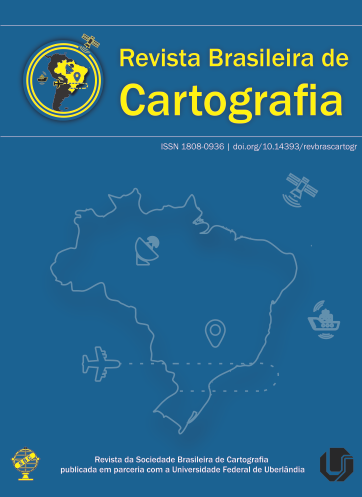Implantação de uma Base de Classificação da Componente Angular de Estações Totais e Teodolitos em Laboratório com Uso de Colimadores
Conteúdo do artigo principal
Resumo
É cada vez mais necessário que processos usados em instrumentação geodésica sejam automatizados, visando a eficiência e redução de tempo de execução. No Brasil e no mundo há diversas normativas que se atém a esta temática, estabelecendo os procedimentos em campo e laboratório para a classificação da componente angular de instrumentos geodésicos. É neste contexto que esta pesquisa projetou e implantou um sistema de classificação da componente angular horizontal de teodolitos e estações totais em laboratório, conjuntamente com a automação do processo de cálculo e emissão de certificado de classificação. Para viabilizar essa proposta, foi reproduzida a mesma condição estabelecida pela NBR 13133/1994 (atualizada em 2021), para uma base de classificação de campo, porém em laboratório, utilizando colimadores para a definição de pontos que serão ocupados pelos alvos (visados). Estes colimadores foram instalados em uma plataforma de concreto, todos no mesmo plano horizontal, de forma que o ângulo horizontal formado entre o primeiro colimador e o último, foi maior que noventa graus. Para garantia da manutenção do mesmo plano horizontal utilizou-se um nível geodésico N3 da Wild. Ao final do processo de coleta de dados (após leituras/medições), estes dados foram inseridos de forma manual pelo operador ou por meio de upload de arquivo com extensão .txt, realizando por meio do MATLAB® (MATrix LABoratory), os cálculos oriundos da Norma e que resultou na emissão automática de um certificado de classificação da componente angular horizontal do instrumento.
Downloads
Detalhes do artigo
Seção

Esta obra está licenciado com uma Licença Creative Commons Attribution 3.0 Unported License.
Autores que publicam nesta revista concordam com os seguintes termos:
- Autores mantém os direitos autorais e concedem à revista o direito de primeira publicação, com o trabalho simultaneamente licenciado sob a Licença Creative Commons Atribuição que permite o compartilhamento do trabalho com reconhecimento da autoria e publicação inicial nesta revista.
- Autores têm autorização para assumir contratos adicionais separadamente, para distribuição não-exclusiva da versão do trabalho publicada nesta revista (ex.: publicar em repositório institucional ou como capítulo de livro), com reconhecimento de autoria e publicação inicial nesta revista.
- Autores têm permissão e são estimulados a publicar e distribuir seu trabalho online (ex.: em repositórios institucionais ou na sua página pessoal) a qualquer ponto antes ou durante o processo editorial, já que isso pode gerar alterações produtivas, bem como aumentar o impacto e a citação do trabalho publicado (veja "O Efeito do Acesso Aberto").





